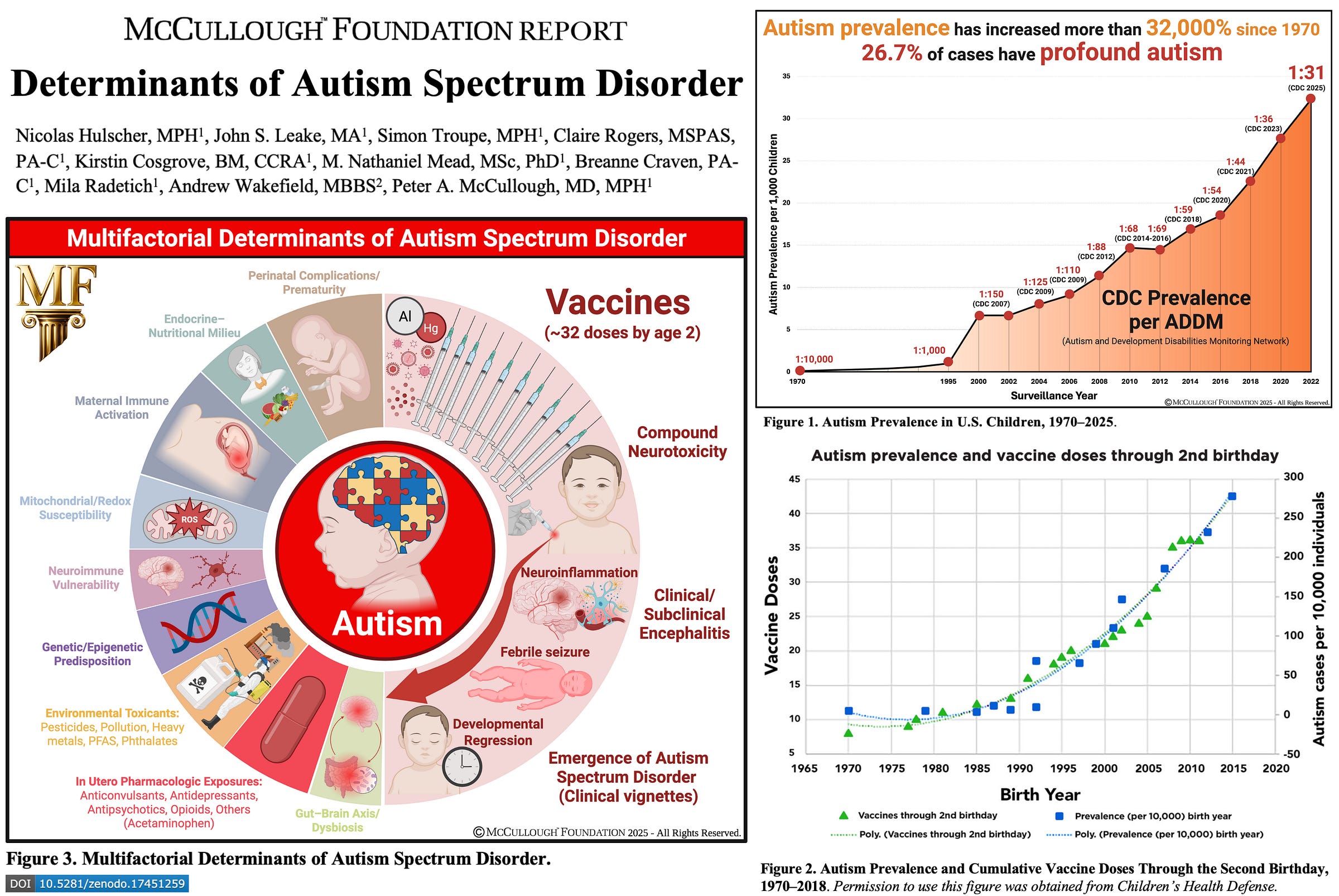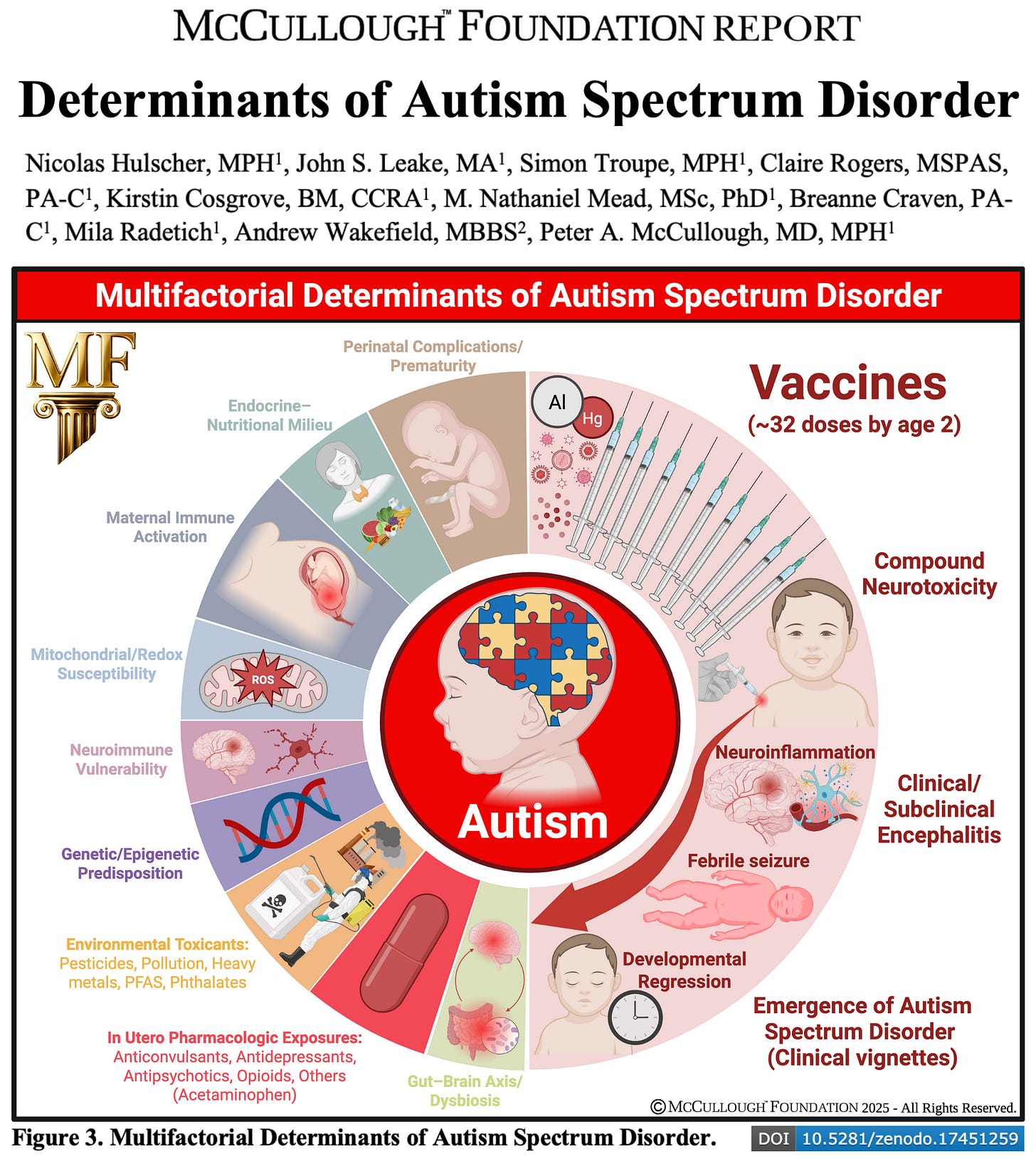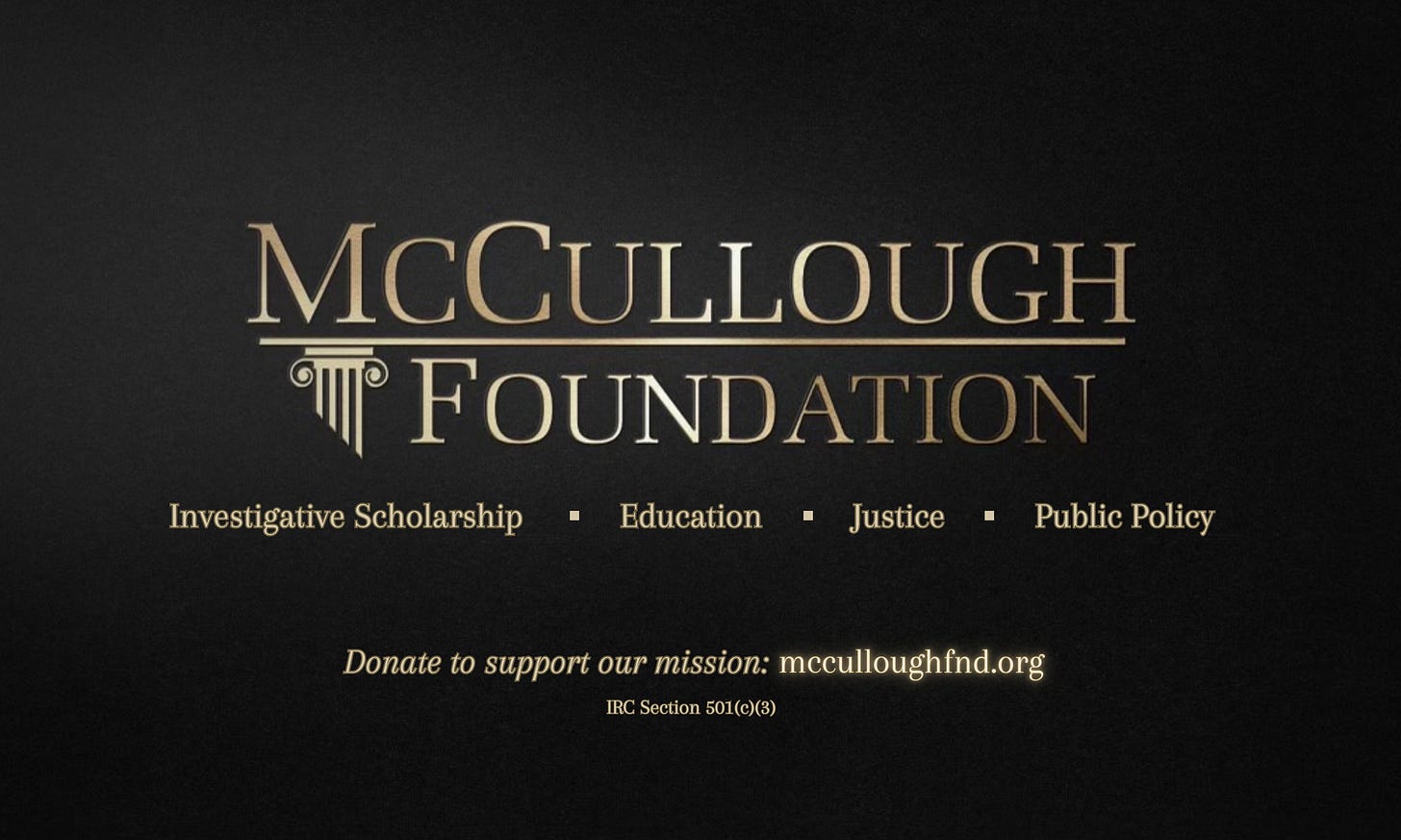BREAKING — Landmark Report Finds Vaccination Is the Dominant Risk Factor for Autism Spectrum Disorder
McCullough Foundation’s authoritative analysis of more than 300 studies provides the most comprehensive synthesis to date on the possible causes of autism.
For decades, scientists have debated what drives the relentless rise in autism. Some have claimed it’s due to “increased screening” while others declare it’s anything but vaccines. Thousands of studies have explored genetic, environmental, and perinatal factors—but very few have ever examined vaccine and non-vaccine determinants together within a unified analytical framework.
Now, the landmark McCullough Foundation Report titled, Determinants of Autism Spectrum Disorder, provides the most comprehensive synthesis on the possible causes of autism to-date. Thanks to the tireless work of Nicolas Hulscher, MPH, John S. Leake, MA, Simon Troupe, MPH, Claire Rogers, MSPAS, PA-C, Kirstin Cosgrove, BM, CCRA, M. Nathaniel Mead, MSc, PhD, Bre Craven, PA-C, Mila Radetich, Andrew Wakefield, MBBS, and Peter A. McCullough, MD, MPH — and support from the Bia-Echo Foundation — this historic effort was made possible.
Our report represents a major breakthrough through the iron grip of censorship imposed by the Bio-Pharmaceutical Complex on the issue of vaccination and autism. It also marks Dr. Andrew Wakefield’s first major return to the scientific literature in years—after enduring years of irrational attacks from the vaccine cartel.
By systematically integrating more than 300 studies across epidemiologic, clinical, mechanistic, and molecular domains, our team delivers the most extensive mapping yet of autism’s multifactorial origins and opens a new line of inquiry into how environmental and iatrogenic exposures intersect with genetic susceptibility.
By evaluating all known risk factors side by side, this analysis uniquely clarifies the relative contribution of vaccination compared to genetic and environmental domains. No prior review has attempted this integrative scope without excluding positive vaccine-association studies or unvaccinated controls—an essential step in determining whether vaccines truly play a role in autism risk, and if so, how significant that role is within the broader causal landscape.
Here’s what we found as described in the Abstract:
Introduction: Autism spectrum disorder (ASD) is now estimated to affect more than 1 in 31 children in the United States, with prevalence rising sharply over the past two decades and posing an increasing burden to families and public health systems. Most of the literature on ASD characterizes it as a complex neurodevelopmental condition shaped by multiple determinants, including genetic liability, immune dysregulation, perinatal stressors, and environmental toxicants. Since 1996, the possible role of childhood vaccination has also been discussed and debated. This review synthesizes the full range of evidence to clarify both vaccine-related and non-vaccine contributors to ASD risk.
Methods: We comprehensively examined epidemiologic, clinical, and mechanistic studies evaluating potential ASD risk factors, assessing outcomes, exposure quantification, strength and independence of associations, temporal relationships, internal and external validity, overall cohesiveness, and biological plausibility.
Results: We found potential determinants of new onset ASD before the age of 9 years old to include: older parents (>35 years mother, >40 years father), premature delivery before 37 weeks of gestation, common genetic variants, siblings with autism, maternal immune activation, in utero drug exposure, environmental toxicants, gut-brain axis alterations and combination routine childhood vaccination. These diverse genetic, environmental, and iatrogenic factors appear to intersect through shared pathways of immune dysregulation, mitochondrial dysfunction, and neuroinflammation, culminating in neurodevelopmental injury and regression in susceptible children. Of 136 studies examining childhood vaccines or their excipients, 29 found neutral risks or no association, while 107 inferred a possible link between immunization or vaccine components and ASD or other neurodevelopmental disorders (NDDs), based on findings spanning epidemiologic, clinical, mechanistic, neuropathologic, and case-report evidence of developmental regression. 12 studies comparing routinely immunized versus completely unvaccinated children or young adults consistently demonstrated superior overall health outcomes among the unvaccinated, including significantly lower risks of chronic medical problems and neuropsychiatric disorders such as ASD. The neutral association papers were undermined by absence of a genuinely unvaccinated control group—with partial or unverified immunization even among those classified as unvaccinated—alongside registry misclassification, ecological confounding, and averaged estimates that obscure effects within vulnerable subgroups. Only a few case–control studies verified vaccination through medical records or parent-held cards, and none performed independent clinical assessments of the children for ASD. In contrast, the positive association studies found both population signals (ecologic, cohort, case–control, dose–response, and temporal clustering) and mechanistic findings converging on biologic plausibility: antigen, preservative, and adjuvant (ethyl mercury and aluminum) induced mitochondrial and neuroimmune dysfunction, central nervous system injury, and resultant incipient phenotypic expression of ASD. Clustered vaccine dosing and earlier timing of exposure during critical neurodevelopmental windows appeared to increase the risk of ASD. These findings parallel strong, consistent increases in cumulative vaccine exposure during early childhood and the reported prevalence of autism across successive birth cohorts. To date, no study has evaluated the safety of the entire cumulative pediatric vaccine schedule for neurodevelopmental outcomes through age 9 or 18 years. Nearly all existing research has focused on a narrow subset of individual vaccines or components—primarily MMR, thimerosal-containing, or aluminum-adjuvanted products—meaning that only a small fraction of total childhood vaccine exposure has ever been assessed for associations with ASD or other NDDs.
Conclusion: The totality of evidence supports a multifactorial model of ASD in which genetic predisposition, neuroimmune biology, environmental toxicants, perinatal stressors, and iatrogenic exposures converge to produce the phenotype of a post-encephalitic state. Combination and early-timed routine childhood vaccination constitutes the most significant modifiable risk factor for ASD, supported by convergent mechanistic, clinical, and epidemiologic findings, and characterized by intensified use, the clustering of multiple doses during critical neurodevelopmental windows, and the lack of research on the cumulative safety of the full pediatric schedule. As ASD prevalence continues to rise at an unprecedented pace, clarifying the risks associated with cumulative vaccine dosing and timing remains an urgent public health priority.
KEY FINDINGS
1. Comprehensive Scope
Included 300+ studies covering genetic, environmental, immune, toxicologic, and vaccine-related factors.
Of 136 studies evaluating vaccines or their excipients, 107 (79%) found evidence consistent with a vaccine–autism link, while 29 reported null results.
Only 12 studies compared fully vaccinated vs. completely unvaccinated children—and every one showed superior health outcomes among the unvaccinated.
2. Methodological Gaps in “Null” Studies
Studies reporting no association consistently lacked genuinely unvaccinated control groups, relied on registry data rather than clinical assessments, and failed to confirm vaccine records.
None employed a formal non-inferiority framework to evaluate autism as a safety endpoint, leaving neurodevelopmental risk effectively untested.
3. Converging Mechanisms of Injury
Across multiple biological domains, evidence converged on shared mechanisms—immune dysregulation, mitochondrial dysfunction, and neuroinflammation—triggered by antigen, preservative, and adjuvant exposure during critical neurodevelopmental windows.
Clustered and early-timed vaccination correlated with higher ASD risk.
4. Broader Determinants
Non-vaccine risk factors—older parents, premature delivery, common genetic variants, siblings with autism, maternal immune activation, in utero drug exposure, environmental toxicants, and gut-brain axis alterations —also contribute, but none can fully explain the sharp rise in autism that coincided with the expansion of the U.S. vaccine schedule post-1986.
5. Policy and Research Implications
No study has ever assessed the entire pediatric vaccine schedule for neurodevelopmental outcomes through age 9 or 18.
Autism prevalence has now reached 1 in 31 U.S. children, underscoring an urgent need for comprehensive safety reevaluation and unvaccinated control cohorts in future studies.
CONCLUSION
This landmark report reveals autism as a multifactorial disorder with intersecting genetic, environmental, and iatrogenic influences—but one dominant, modifiable factor stands out. Combination and early-timed vaccination emerges as a major driver of risk—consistent across mechanistic, epidemiologic, and clinical evidence.
As autism prevalence continues to rise at an unprecedented pace, clarifying the full neurodevelopmental impact of the modern vaccine schedule is no longer optional—it’s a moral and scientific imperative.
Read the full report here: https://zenodo.org/records/17451259
Read the full press release here:
EPILOGUE
This project began earlier this year and quickly grew into one of the most ambitious analyses our team has ever undertaken. Over the past several months, we have invested countless hours reviewing, categorizing, and cross-checking data from more than 300 studies to produce this landmark report. The work required meticulous attention to every detail to ensure the most accurate synthesis possible.
This research was made possible through generous support from the Bia-Echo Foundation, which recognized the importance of independent scientific inquiry, along with the commitment of our many honorable donors. Yet sustaining this level of investigation—spanning fact-checking, figure development, and manuscript production—requires continued resources and support.
If you would like to help us expand this vital work, please consider supporting future analyses through the McCullough Foundation. Every contribution directly fuels ongoing independent research, publication, and public-education efforts.
Support our mission today: mcculloughfnd.org/products/donate-1
Epidemiologist and Foundation Administrator, McCullough Foundation
Support our mission: mcculloughfnd.org
Please consider following both the McCullough Foundation and my personal account on X (formerly Twitter) for further content.






Thank you to the McCullough Foundation for doing this study! I have a 21 year old son with profound autism. I was 32 when I was pregnant and just turned 33 when I gave birth to him. I wasn't considered to be an "older mother". I never took any medications during pregnancy. I never took Tylenol or anything. I only took prenatal vitamins. My son was full term at 40 weeks and he was 8 Ibs and 10 ozs. Pregnancy was uneventful and it was a natural birth. He did received the Hep B vaccine at birth without my permission. Nobody was questioning vaccines in 2004 and I didn't know there were potential issues with vaccines. He received all of his vaccines according to the childhood vaccination schedule. We stopped all vaccines by 2 or 3 years old. He was diagnosed with autism at 2 years old. He regressed after each round of vaccines. He had eczema and GI issues. He eventually developed seizures. There's no other explanation for his autism than the vaccines. This crime against children must stop!
Funny that's just what has been categorically denied so many times.
Have you let Bobby Jr. and The Donald know about this?